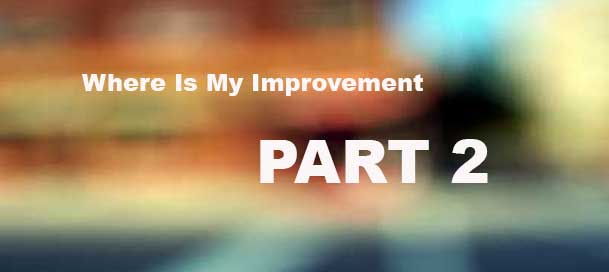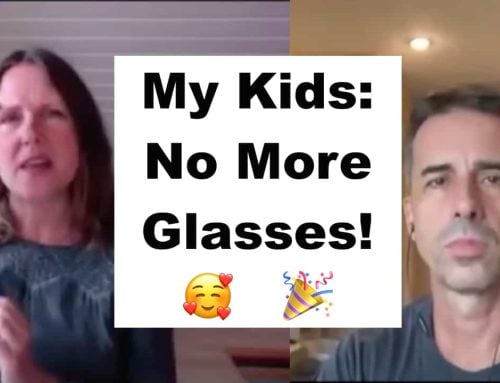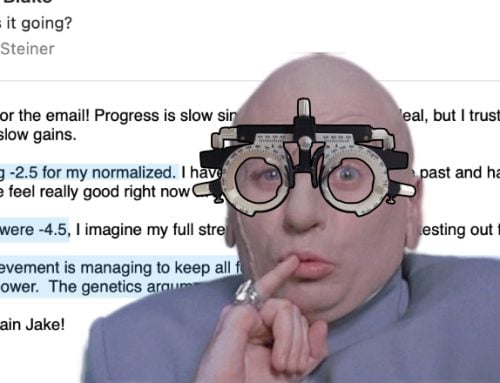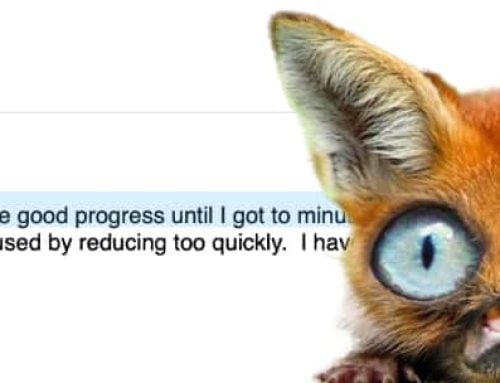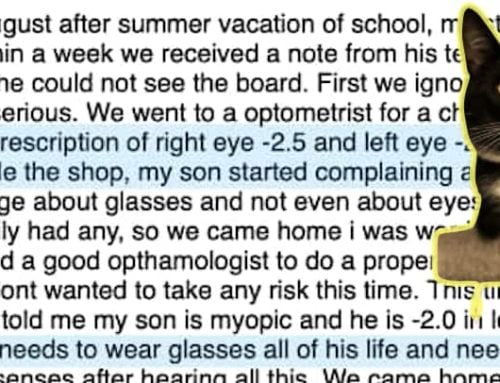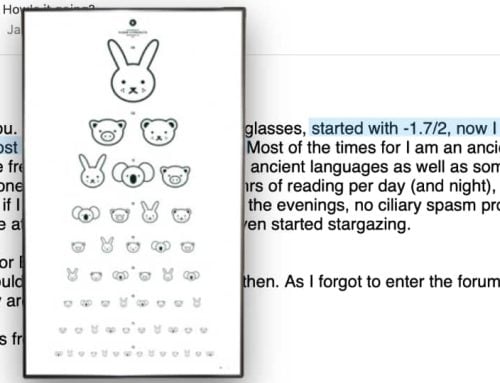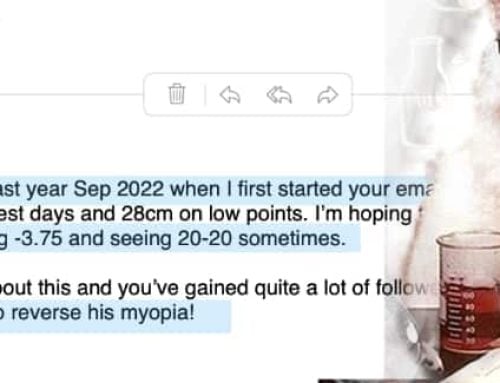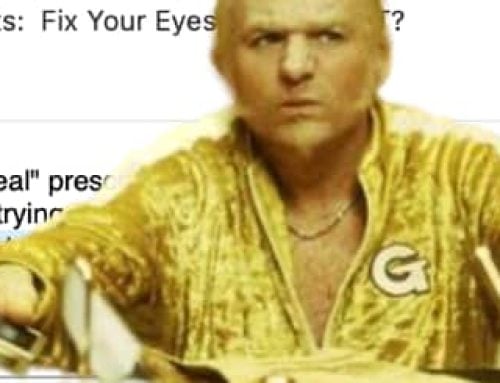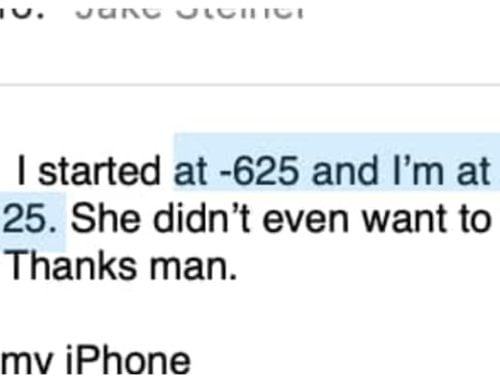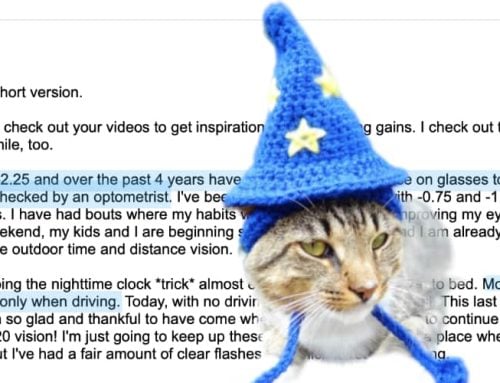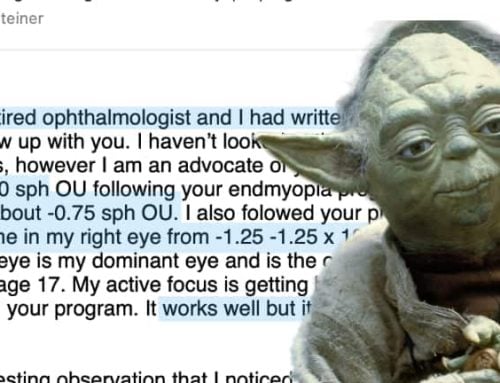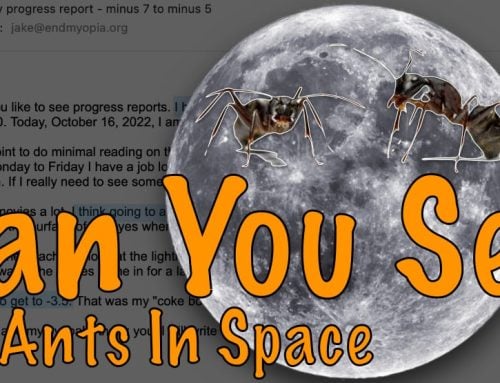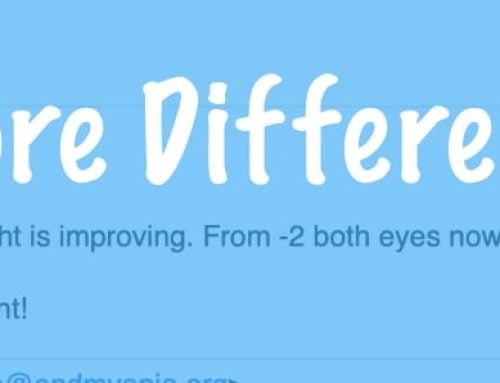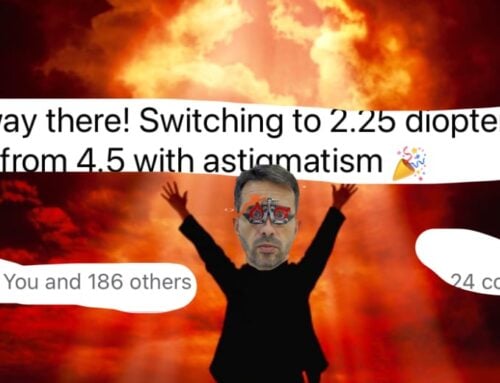This is part two of this article based on this forum thread.
I was curious to see what might happen, if I don’t jump in but rather let readers use Jessi’s clues to find an answer to her question. The (part 1) article was meant to highlight that sense of struggle that is common especially when we are working our way back from high myopia.
Coincidentally (and ironically perhaps), the article coincided with quite a traffic spike, which may have confused some poor first time visitors. We did have more e-mail newsletter sign-ups than ever before, so things must still have been interesting for our new readers.
You may remember Jessi’s original forum question:
![]() I’ve been doing the program for a year now and while I’ve noticed improvements in the vision I can achieve (measured on the snellen chart) with both prescriptions, my vision without glasses remains the same at 11cm/12cm. I’m starting to get a little disheartened. Can anyone shed light on why my vision with glasses is improving but my vision without is not?
I’ve been doing the program for a year now and while I’ve noticed improvements in the vision I can achieve (measured on the snellen chart) with both prescriptions, my vision without glasses remains the same at 11cm/12cm. I’m starting to get a little disheartened. Can anyone shed light on why my vision with glasses is improving but my vision without is not?
This is where persistence is as important as communication.
Rather than making this site just a library of myopia rehabilitation content, we have a community aspect, as well as me to help with questions. I think this is very important, especially in a situation like Jessi’s, where it may be difficult to continue, without having others to share their findings.
I responded to the thread with just enough clues to suggest something else may be going on, and left it there for others to chime in.
Then Ingrid added her experiences. Which are interesting as Ingrid experienced a really significant amount of improvement in a short time (from -7 diopters to 20/20 without glasses, in good lighting). While her approach doesn’t address Jessi’s particular issue here exactly, Ingrid’s input and experiences are always worth reading closely (quite a few things she did, greatly helped her with her rapid recovery).
Then Tom hit the nail on the head, with his post:
![]() Jessi. As you have noticed the centimeter measurement is precise up to +- 1cm. To put this into perspective. 10cm corresponds to -10D. 11cm to -9D, 12cm to -8.3D, and 13cm to -7.7D. At your level of myopia, 1cm makes a huge difference – and that’s not going to happen overnight.
Jessi. As you have noticed the centimeter measurement is precise up to +- 1cm. To put this into perspective. 10cm corresponds to -10D. 11cm to -9D, 12cm to -8.3D, and 13cm to -7.7D. At your level of myopia, 1cm makes a huge difference – and that’s not going to happen overnight.
Personally, I find my distance vision to be the most representative picture of my refractive status. I can usually see if I’m doing good when I walk outside looking far.
On the close strain front, you might want to challenge yourself a bit by staying a bit beyond 50cm when doing close work. Reducing close work load is also a good idea (not always practical though).
On the lighting front, it’s a good idea not to do focusing under a dim/dark environment.
I tend to find the amount of improvement depends on how much I challenge your eyes. Days of close-work-as-usual, while keeping good visual habits, usually don’t lead to much change for me.
I was quite excited to read this, as even though the forum is still quite new, we have participants willing to log in and share their understanding of myopia, centimeter results, and what I think of as a universally correct approach to the problem. Very nicely done, Tom.
Then Lee added some more perspective with numbers:
![]() -11.5 down to -9.5, with 20/25 vision. And even with -8.00 you could briefly read 20/20 clearly! I think that is some pretty great progress. You are reducing those prescriptions and your eyes are following right along.
-11.5 down to -9.5, with 20/25 vision. And even with -8.00 you could briefly read 20/20 clearly! I think that is some pretty great progress. You are reducing those prescriptions and your eyes are following right along.
Also what Tom said. 2 centimeter is quite a lot, when it’s from a total of 11cm to 13cm … that’s something close to 20%!
And I also had some more direct dialog with Jessi (as she is in one-on-one), with additional suggestions on what we want to look at.
Just how much latitude there is for her, in terms of pursuing some prescription reductions, is an important topic here. And Jessi gets right into this very subject, with another comment in the thread:
![]() Just as an aside, something strange happened yesterday, I was outside using my Snellen chart in bright daylight and when I put my differential prescription on there was a period of about 15 seconds where I could very clearly read the 20/20 line! Not sure why this happened but it was very cool. I took it as a sign that I’m on the right track.
Just as an aside, something strange happened yesterday, I was outside using my Snellen chart in bright daylight and when I put my differential prescription on there was a period of about 15 seconds where I could very clearly read the 20/20 line! Not sure why this happened but it was very cool. I took it as a sign that I’m on the right track.
We discuss peak prescription for this reason, in the advanced part of the program.
Jessi could see 20/20, briefly, with a -8.00 prescription. She had started with a -11.5 prescription!
Of course, some of this can be an original overprescription, of course we are using best case lighting scenario, of course this isn’t her immediate, consistent result. Still, that is a very notable 30% better than where we started. There are lots of reasons one might say “but” … to which I say:
If you can see 20/20, you are seeing 20/20.
If you can pick up a heavy object once, it means you are capable of it. This is a very key realization, and has to be used to set the bar for oneself.
Getting this best result more consistently, is now the game. Using that -8.00 on sunny days, while walking outdoors, while pulling focus, is where we want to be. Sure it’s fine to use the previous normalized for overcast days, or when we aren’t actively working on improvement. But when your eyes say “I can see perfectly fine with a -8.00”, then we must challenge our eyes to reproduce this.
And once you get it once, you will get it again. And with a bit of work and patience, it will come quicker, easier, more often, in more varying conditions.
And before you know it, that -8.00 is your new regular prescription, and you consistently see 20/20 with it.
This is the game.
First we learn about strain, about prescriptions, we start building basic habits. Then we get into advanced subjects, like double vision, peripheral vision, dietary details, better lighting, optimizing our environment. And eventually, when it is all just a simple habit, we start to look for these little signs of breakthrough potential. When we get that 20/20 moment with the glasses that are supposed to be one to two diopters too low (because they are supposed to just be our reading/ differential prescription).
It can take time, but that’s why we have habits. And that is why we keep logs, and have a Snellen chart mounted somewhere easily visible.
We set the stage so when we get that clear flash, the moment of unexpected better vision, we can reset the bar and begin working on making that moment of clarity our new default.
And then, we are back to waiting, patiently, like a fisher man in the boat, for the next glimpse of improvement.
Thanks to Jessi, and all of those who contributed to the original thread, for this excellent and important conversation.
Enjoy!

